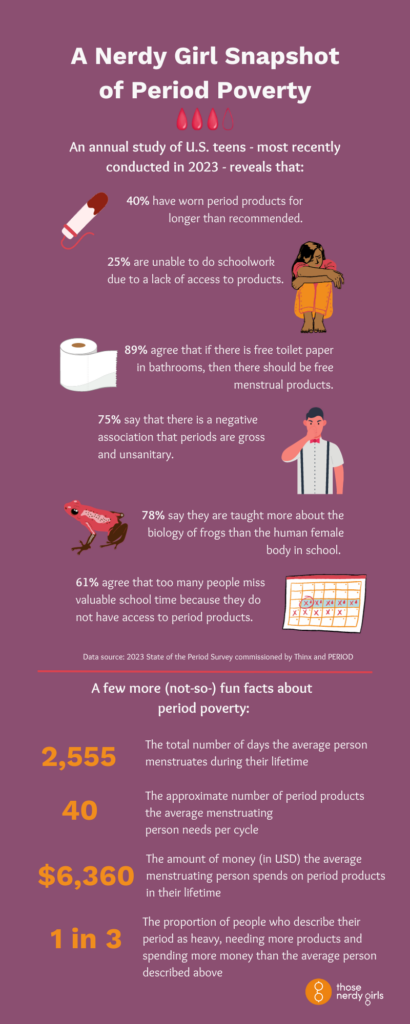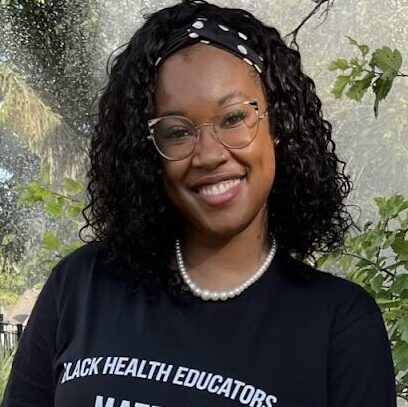A: Period poverty refers to the additional costs (financial, social, or societal) incurred from menstruating.
TLDR: Over two thirds of people who menstruate have trouble paying for period supplies, many of whom are low income or from a historically marginalized group. Expanding access to more affordable or free supplies can make it easier for these folks to attend work and school, and has mental health benefits.
At its most basic, period poverty is the inability to afford sufficient menstrual products. The concept can be expanded to include the inability to access basic sanitation services or facilities, menstrual hygiene education, and even injustices and inequalities for those who menstruate (e.g. workplace discrimination). Period poverty disproportionately affects those with either low income, lack of stable housing, or both.

Many people falsely assume that inequalities in menstrual hygiene only occur in countries without access to clean water and facilities. But keeping oneself healthy during menstruation also includes having adequate supplies. Unfortunately, lack of access to period products is fairly common, even in the US.
There are more than 76 million people of childbearing age in the United States. One study among low-income women found that over 60% (1) could not afford menstrual hygiene products during the previous year. In another study, about one-third of teens (2) reported missing school due to a lack of products. In a more recent analysis, women who had experienced period poverty in the past were 4 times more likely to have difficulty accessing products during the pandemic (3).
Period products, unlike other essential items like food (and energy drinks!![]() ), cannot be purchased with SNAP or WIC funds. Some organizations have tried to fill the gap with diaper banks or community programs, but this is not always enough. For those of us that have been there, we make do: using cloth, rags, tissues, toilet paper, paper towels, or even infant diapers, according to one study.
), cannot be purchased with SNAP or WIC funds. Some organizations have tried to fill the gap with diaper banks or community programs, but this is not always enough. For those of us that have been there, we make do: using cloth, rags, tissues, toilet paper, paper towels, or even infant diapers, according to one study.
Not having the proper supplies to take care of our own bodily needs can be demoralizing, and affect mental health. In a study of university students, women who had experienced period poverty in the past year were twice as likely (4) to experience moderate/severe depression compared to those who had never experienced period poverty.
Evidence on whether period poverty can increase the likelihood of a vaginal or urinary tract infection are mixed, mostly because of the lack of high quality studies. Compared to subjects that traditionally fall under men’s health, there is very little literature on menstruation and more research is needed to understand the physical risks of period poverty.
22 countries, including Canada, Mexico, the UK, India, and South Africa, do not tax period products; 20 US states still tax these items and some impose additional local taxes. Kenya, New Zealand and Australia offer free products in all their schools and France will begin offering free products to everyone under 25 starting in 2024. In the US, only 26 states either provide funding for or require period products in schools. Scotland offers free period products to everyone.
Bottom line: Menstruating people spend more money than their non menstruating counterparts to take care of basic hygiene needs. Expanding access to affordable or free period products can ensure that people who cannot afford them are able to work to support their families, stay in school, and maintain their overall mental well-being.
Those Nerdy Girls
Further Reading and Resources:
Alternative Resources for Period Products
Period poverty: why it should be everybody’s business
National Petition to End Period Poverty
Selected references:
Unmet Menstrual Hygiene Needs Among Low-Income Women
COVID-19 made it harder to access period products: The effects of a pandemic on period poverty – PMC (nih.gov)
Period poverty and mental health implications among college-aged women in the United States



